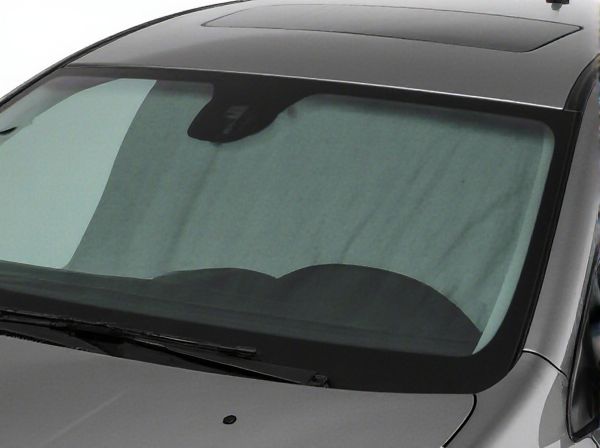
Photo illustration: UV Filtering Windshield vs Standard Windshield
A UV filtering windshield significantly reduces harmful ultraviolet rays from entering your vehicle, protecting both your skin and the interior from sun damage. Standard windshields offer basic protection but lack the specialized coating that blocks UV radiation, leading to increased exposure. Choosing a UV filtering windshield enhances comfort and safety during long drives, especially in sunny conditions.
Table of Comparison
| Feature | UV Filtering Windshield | Standard Windshield |
|---|---|---|
| UV Protection | Blocks up to 99% of harmful UV rays | Minimal to no UV blockage |
| Interior Fading | Prevents fading and cracking of dashboard and seats | Allows UV rays that accelerate interior damage |
| Driver Comfort | Reduces glare and heat inside the car | Higher glare and interior heat |
| Health Benefits | Protects skin from UV-related damage during driving | No significant UV protection for occupants |
| Cost | Higher upfront cost due to special coating | Lower initial cost |
| Durability | Comparable to standard windshields | Standard durability |
Introduction to Windshield Technologies
UV filtering windshields incorporate specialized interlayers or coatings designed to block harmful ultraviolet rays, enhancing occupant protection and reducing interior fading compared to standard windshields. Standard windshields primarily focus on impact resistance and visibility, using laminated glass without advanced UV blocking properties. Modern windshield technologies integrate UV filters to improve vehicle comfort and long-term durability by minimizing sun-related damage.
What is a UV Filtering Windshield?
A UV filtering windshield is designed with advanced laminated glass layers that block up to 99% of harmful ultraviolet rays, protecting vehicle occupants from skin damage and interior fading. Unlike standard windshields, which primarily offer impact resistance and basic visibility, UV filtering windshields incorporate special interlayers that reduce UV radiation without compromising clarity or safety. This technology enhances comfort and helps preserve the car's interior materials, making it a valuable upgrade for long-term vehicle protection.
How Standard Windshields Work
Standard windshields are typically made from laminated glass consisting of two layers of glass with a plastic interlayer, which provides structural integrity and basic protection against debris. They block a significant portion of UVA and UVB rays, reducing sun damage and glare, but lack specialized UV filtering coatings found in UV filtering windshields. The plastic interlayer, usually polyvinyl butyral (PVB), naturally absorbs some ultraviolet radiation, offering passive protection without the advanced filtering technology.
Key Differences Between UV Filtering and Standard Windshields
UV filtering windshields are designed with special coatings or laminated layers that block up to 99% of harmful ultraviolet rays, providing enhanced protection for vehicle occupants and interior materials. Standard windshields typically offer minimal UV protection, allowing more ultraviolet light to penetrate, which can accelerate interior fading and increase skin exposure risks. The key difference lies in UV filtering windshields' ability to reduce UV-induced damage and improve comfort by minimizing heat buildup, whereas standard windshields primarily focus on structural integrity without significant UV mitigation.
Health Benefits of UV Filtering Glass
UV filtering windshields block up to 99% of harmful ultraviolet rays, significantly reducing the risk of skin cancer and premature skin aging for drivers and passengers. Unlike standard windshields that allow UVA rays to penetrate, UV filtering glass protects eyes from cataracts and other UV-related damage. This advanced glass enhances in-car air quality by minimizing UV-induced degradation of interior materials that can release harmful chemicals.
Impact on Vehicle Interior Preservation
UV filtering windshields significantly reduce the penetration of harmful ultraviolet rays, helping to prevent fading and cracking of dashboard materials, upholstery, and other interior components. Standard windshields lack this protective layer, allowing more UV exposure that accelerates the deterioration of plastics, leather, and fabrics within the vehicle. Incorporating UV filtering technology in windshields effectively extends the lifespan of interior surfaces, maintaining vehicle resale value and comfort over time.
Cost Comparison: UV Filtering vs. Standard Windshields
UV filtering windshields typically cost 20-30% more than standard windshields due to advanced materials and coating technologies that block harmful ultraviolet rays. The higher upfront cost can be offset by reduced interior damage and lower risk of skin-related health issues from prolonged UV exposure. Standard windshields offer a more affordable initial investment but lack the long-term protection benefits that justify the premium price of UV filtering glass.
Installation and Maintenance Considerations
UV filtering windshields require precise installation to maintain their protective coating integrity, often necessitating specialized adhesives and professional expertise. Standard windshields offer more straightforward installation processes with readily available materials and less sensitivity to environmental conditions. Maintenance for UV filtering windshields involves careful cleaning with non-abrasive products to preserve UV filtering properties, whereas standard windshields tolerate a wider range of cleaning methods without risking coating damage.
Safety Features and Testing Standards
UV filtering windshields offer enhanced protection by blocking up to 99% of harmful ultraviolet rays, reducing glare and preventing interior fading, which improves driver visibility and comfort. They undergo rigorous safety testing under standards such as ANSI Z26.1 and FMVSS 205, ensuring impact resistance and shatter-resistance comparable to standard windshields. Standard windshields primarily prioritize structural integrity and impact safety but lack the advanced UV protection that can reduce eye strain and potential skin damage during prolonged driving.
Making the Right Choice for Your Vehicle
Choosing a UV filtering windshield over a standard one enhances protection by blocking up to 99% of harmful ultraviolet rays, reducing interior fading and skin damage. UV filtering windshields also improve comfort by minimizing glare and heat buildup inside the vehicle, resulting in a cooler cabin environment. Prioritizing UV protection ensures long-term preservation of your vehicle's interior while safeguarding your health during daily drives.
 caratoz.com
caratoz.com